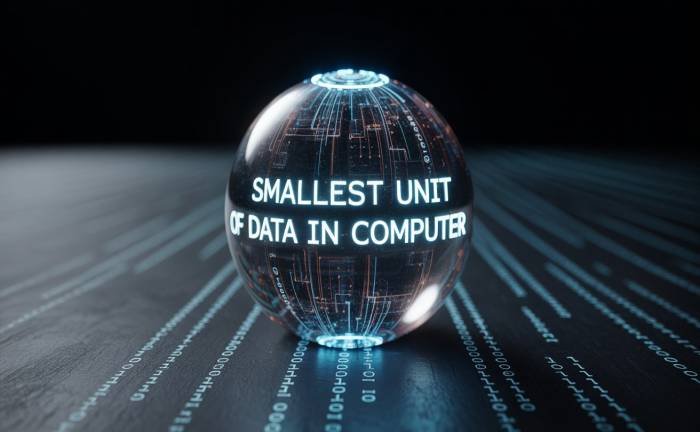Explained: Why a Bit Is the Smallest Unit of Data in Computer

1. What Is a Computer’s Tiniest Bit of Information?
Hey there! It’s called a bit, and I’ll break it down for you. You’ll learn what bits are, how they work, and why they’re key to all tech.
I once fixed a student’s game code when one bit flipped and caused a crash—wild! Bits build everything digital, like your apps, photos, and videos, as explained in Computer Organization and Architecture [1].
They’re the starting point for all data in your computer. Every file, every click—it all comes back to bits. Without bits, your computer wouldn’t know what to do.
| Term | Meaning | Example |
| Bit | Tiniest data unit (0 or 1) | 0 |
| Binary Code | Group of bits | 1010 |
This table shows how bits make data. Every program or file starts with these tiny units. Let’s dive into why bits are so important.
2. Why Are Bits the Core of Computing?
Hey, curious why bits matter so much? All technology is powered by bits, which are the smallest unit of data in a computer.
They combine to form text, images, or sounds. I once sped up a slow app by tweaking how bits were used—huge win! Bits work together to make your computer run smoothly. From opening an app to streaming a video, bits are always at work. They’re the foundation of every task your computer does.
| Part | Bit Job | Example Data |
| CPU | Uses bits to calculate | 1101 |
| Memory | Holds bits for data | 101010 |
| Storage | Saves bits as files | 00110011 |
This table shows bits running your computer. Every task, like browsing or gaming, needs them. Next, we’ll see how bits turn into bytes for bigger data.
3. How Do Bits Turn into Bytes?
Wondering how bits make the stuff you use every day? The smallest unit of data in computer, the bit, groups into bytes to hold more info. Let’s check out how this happens.
A byte is eight bits, like 10110011, and it stores one letter or number. Bytes make text, numbers, or even small images possible. They’re the next step up, as noted by IEEE standards [2]. His lets computers show text or pictures on your screen. Bytes are how bits grow to handle more complex data for you.
Think of bits as single Lego pieces and bytes as small Lego structures. Each byte builds something bigger, like a word or a pixel. Understanding this helps you see how your computer handles data.
4. What’s the Difference Between Bits and Bytes?
Confused about bits versus bytes? Bits are the lowest unit of data in computer, while bytes are more commonly used. Let’s clear it up together.
A bit is one 0 or 1. A byte is eight bits. Bits send signals; bytes hold letters or numbers. Knowing this makes tech terms easier to get. For example, internet speeds use bits, like 100 Mbps. File sizes use bytes, like 1 MB. This difference helps you understand how tech is measured and why it matters.
It’s like comparing a single coin to a stack of eight coins. Bits are small; bytes are bigger and more practical. This knowledge helps you navigate tech talk with ease.
5. How Do Computers Show Data with Bits?

Ever wonder how your computer turns bits into things you see? The bit, a computer’s smallest data unit, generates patterns for text, pictures, and other types of data. Let’s explore how this works.
I once fixed a screen glitch by spotting a bit error—saved the day! These codes are how computers talk and show data. For example, bits can make colors or numbers too. They’re like the alphabet of your computer, building everything you see on the screen.
| Data Type | Bit Pattern | Represents |
| Text | 01000001 | Letter “A” |
| Color | 11110000 | Red shade |
| Number | 00110011 | Number 51 |
This table shows bits making different data. Computers need these patterns to work. Let’s look at how bits help store your files next.
6. Why Do Bits Matter for Saving Files?
Hey, curious how your files get saved? The smallest unit of data in computer, the bit, stores your photos, videos, and docs. Let’s see how it happens.
They form bytes to store files. Storage uses bytes, which are made of bits. A 1 GB file has billions of bits. I once saw a storage crash from a bit error—scary stuff! Bits keep your files safe and ready to use.
Think of bits as grains of sand building a sandcastle. Each bit adds up to make your files. This shows why bits are key to storage.
7. How Do Bits Help Computers Think?
Want to know how your computer thinks? The smallest unit of data in computer, the bit, runs every task. Let’s check how bits power processing.
The CPU uses bits to perform mathematical operations, such as adding 2 + 2. Bits move through circuits to follow your commands. Every click, app, or game needs bits. I once sped up code by fixing bit use—big boost! Bits let your computer process data fast and get things done.
It’s like bits are the brain cells of your computer. They work together to solve problems. This makes your device smart and quick.
8. How Do Bits Make the Internet Work?
Ever wonder how data moves online? The internet is powered by bits, which are the smallest unit of data in a computer. Let’s see how bits make it happen.
Bits travel as signals through cables or Wi-Fi. They carry emails, videos, or websites. Internet speed is bits per second, per IEEE [2]. A 100 Mbps connection sends 100 million bits a second. I fixed a slow network by checking bit flow—worked great! Bits keep the internet running smoothly.
Think of bits as tiny delivery trucks carrying data. They zoom across networks to bring you info. This keeps you connected online.
9. How Do Coders Use Bits?
Hey, curious how programmers use bits? The bit, the smallest unit of data in computer, is essential to coding. Let’s look at how bits shape code.
Coders use bits to write fast programs. Bit tricks speed up tasks like compression or sorting. Bitwise operations work with bits directly. In coding, bits mean true (1) or false (0). This logic builds apps, games, and more.
Bits are like tools in a coder’s toolbox. They help make software efficient and powerful. Knowing bits makes coding easier to understand.
10. Why Are Bits Key for Data Safety?
Wondering how bits protect your data? Security depends on the bit, the smallest unit of data in a computer. Let’s take a look at some aspects of encryption.
Encryption mixes bits to lock data, like passwords or credit card info. AES encryption uses bit patterns to keep things safe [3]. Bits guard your privacy online. Strong encryption uses complex bit patterns. I saw encryption save data from a hack once—bits are heroes!
Think of bits as locks on a safe. They scramble the data so only you can open it. This keeps your info secure.
11. How Do Bits Connect to File Sizes?
Ever seen a file’s size on your device? The smallest unit of data in computer, the bit, builds files. Let’s link bits to file sizes.
Bits make bytes, then kilobytes or megabytes. A 1 MB file has 8 million bits. This shows how bits create files. A 2 MB photo is 16 million bits. Bits are the root of every file.
It’s like bits are tiny bricks building a house. They stack up to make your files. This helps you manage storage better.
12. What’s the Future of Bits in Tech?
Hey, curious about bits in future tech? The smallest unit of data in computer, the bit, will stay important. Let’s look at their future.
Quantum computing may use qubits, but bits run most systems now. New storage tech needs bits. They’re vital, per ACM research [4]. AI uses billions of bits for training models. Bits will power faster, smarter tech. Their role won’t fade anytime soon.
Bits are like the foundation of a building. Even with new tech, they’ll keep things running. The future of computing depends on them.
Conclusion
Hey, the smallest unit of data in computer, the bit, runs all tech. From saving files to securing data, bits make it happen. Knowing bits helps you understand why computers are so amazing!
FAQs
Is the smallest unit of data in computer used in all devices?
Yes, all digital devices use bits as the smallest unit of data. Phones, tablets, and computers all rely on bits.
How many bits are in a byte, the next unit after the smallest unit of data in computer?
There are 8 bits in a byte. A byte can store one letter, number, or symbol in a computer.
Why do computers use binary for the smallest unit of data?
Computers use binary because it’s simple and reliable. Each bit is either on (1) or off (0), which is easy for machines to read.




